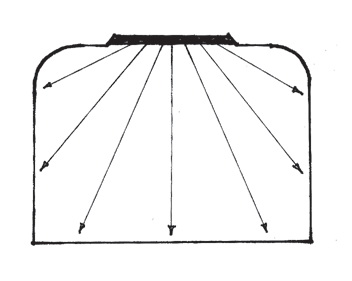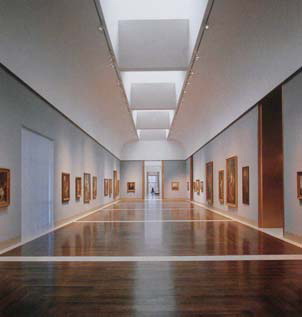พิพิธภัณฑ์ศิลปะเป็นสถานที่รวบรวมและแสดงศิลปกรรมอันทรงคุณค่าของทุกอารยประเทศ
ที่มีความสำคัญในการอนุรักษ์ศิลปกรรมให้คงสภาพเดิมอย่างยาวนาน และการเผยแพร่คุณค่าแห่ง
ศิลปกรรมให้สาธารณชนได้ชื่นชม เรียนรู้ ทั้งร่องรอยศิลปวัฒนธรรมในอดีตและศิลปกรรมที่ศิลปิน
สร้างสรรค์ขึ้นในช่วงเวลาร่วมสมัย
ห้องแสดงศิลปกรรมจำเป็นต้องได้รับการออกแบบและมีระบบการบริการที่ตอบสนองทั้งด้าน
การอนุรักษ์ และการเผยแพร่รูปแบบของห้องแสดงสัมพันธ์กับรูปแบบในการจัดระบบแสงที่ทำให้
แสงสว่างมีความเหมาะสม ไม่ทำให้ศิลปกรรมเสื่อมสภาพเสียหาย และไม่รบกวนสายตาในการชม
ศิลปกรรมที่จัดแสดงในห้องนั้นๆ
พิพิธภัณฑ์ศิลปะที่มีชื่อเสียงไม่ว่าจะเป็นพิพิธภัณฑ์ลูฟร์ (Louvre) ในฝรั่งเศส บริติสมิวเซียม
(British Museum) ในอังกฤษ หรือ Uffizi Gallery ในอิตาลี ฯลฯ ล้วนให้ความสำคัญกับระบบแสง
ระดับแสงสว่าง และการออกแบบรูปแบบการให้แสงสว่างในห้องแสดงศิลปกรรมเป็นอย่างมาก
การออกแบบรูปแบบการให้แสงสว่างมีความพิถีพิถันสูงมาก ไม่มีหลอดไฟหรือดวงไฟรบกวน
สายตาผู้ชม สภาพแสงนุ่มนวล ระดับความสว่างเหมาะสมกับการมอง ไม่น้อยจนมองไม่เห็นรายละ
เอียดหรือไม่มากจนมีส่วนทำให้ศิลปกรรมเสื่อมสภาพเสียหาย และมักจะไม่อนุญาตให้ถ่ายภาพผล
งานจิตรกรรม เพราะแสงแฟลชอาจมีผลเสียต่อสีในผลงานศิลปกรรมได
้ ความสัมพันธ์ของรูปแบบห้องแสดงศิลปกรรมกับรูปแบบของระบบแสงพอที่จะจำแนกได้เป็น
5 รูปแบบ ดังนี้
รูปแบบที่ 1 รูปแบบของห้องเป็นสี่เหลี่ยมผืนผ้าแคบยาว ผนังห้องเชื่อมต่อกับเพดานใน
ลักษณะระนาบโค้งมน ไม่มีมุม เพดานใช้กระจกพรางแสงจากธรรมชาติ หรือติดหลอดไฟเหนือ
กระจกพรางแสง (ภาพที่ 1 ) ห้องแสดงในรูปแบบนี้มีที่พิพิธภัณฑ์ลูฟร์ เป็นต้น (ภาพที่ 2 )
 |
 |
ภาพที่ 1
ภาพลายเส้นแสดงลักษณะห้องและระบบแสงรูป
แบบที่ 1
Picture 1 Lined pattern showing
the gallery and the lighting in style 1.
|
ภาพที่ 2
ห้องแสดงศิลปกรรมในบริติช มิวเซียม
Picture 2 The Gallery in British Museum
|
The light in the Art Museums Gallery
Boonpard Cangkamano
Art museum is the place where keeps and exhibits the valuable artworks of each civilized country. Its importance is to preserve and to maintain the artworks in a good long term condition.Besides these, it is the place where exposes the esthetic value of the artwork so that the public canappreciate and learn the past cultural trail and also presents the artworks which the artist created in the contemporary time.
The art museums gallery needs to be designed and to have the service system that can support both the conservation and its style is presentation by relating to the lighting style providing the suitable light intensity. That means, it should not damage the artwork and bother the sight of
visitor during the visiting in that gallery.
The well-known art museums such as The Louvre in France, British Museum in United Kingdom or Uffizi Gallery in Italy, highly give the importance to the lighting style and the illumination in the gallery.
|
รูปแบบที่ 2 รูปแบบห้องที่ผนังห้องเชื่อมต่อกับเพดานในลักษณะระนาบโค้งแคบ ติดหลอดไฟ
เหนือกระจำพรางแสงกลางเพดานและตลอดแนวส่วนบนของผนังส่องไฟเข้าหาระนาบโค้งและเพดานให้
แสงสะท้อนกระจกไปทั่วห้อง (ภาพที่ 3 ) เช่นที่พิพิธภัณฑ์ลูฟร์และบริติส มิวเซียม เป็นต้น (ภาพที่4)
รูปแบบที่ 3 ห้องที่มีลักษณะเพดานแบบโค้งสูง หรือทรงปิรามิด แสงสว่างส่องจากส่วนบน
สุดจากหลอดไฟหรือแสงธรรมชาติ รูปแบบนี้ถ้าห้องกว้างมาก อาจติดวัสดุพรางแสง (ภาพที่ 5, 6 )
เช่น พิพิธภัณฑ์ Richard Meier Museum (ภาพที่ 7 )
รูปแบบที่ 4 ห้องมีลักษณะสี่เหลี่ยมธรรมดา มีเพดานแบนราบ ถ้าห้องมีพื้นที่น้อย จะติดไฟ
ซ่อนหลอดในเพดานเหนือกระจกพรางแสงเล็กน้อยเพื่อให้แสงสว่างเพียงพอ ถ้าห้องมีขนาดใหญ่จะเพิ่ม
แสงกลางเพดานเพื่อให้กลางห้องสว่างขึ้น (ภาพที่ 8 ) บางแห่งติดหลอดไฟซ่อนในผนังเจาะช่องติด
วัสดุสะท้อนแสง (ภาพที่ 9 ) เช่น พิพิธภัณฑ์ Tate Gallery (now the Tate Britain) ในอังกฤษ และที่ปอมปิดู (Centre Georges Pompidou) ในฝรั่งเศส (ภาพที่ 10 )
|